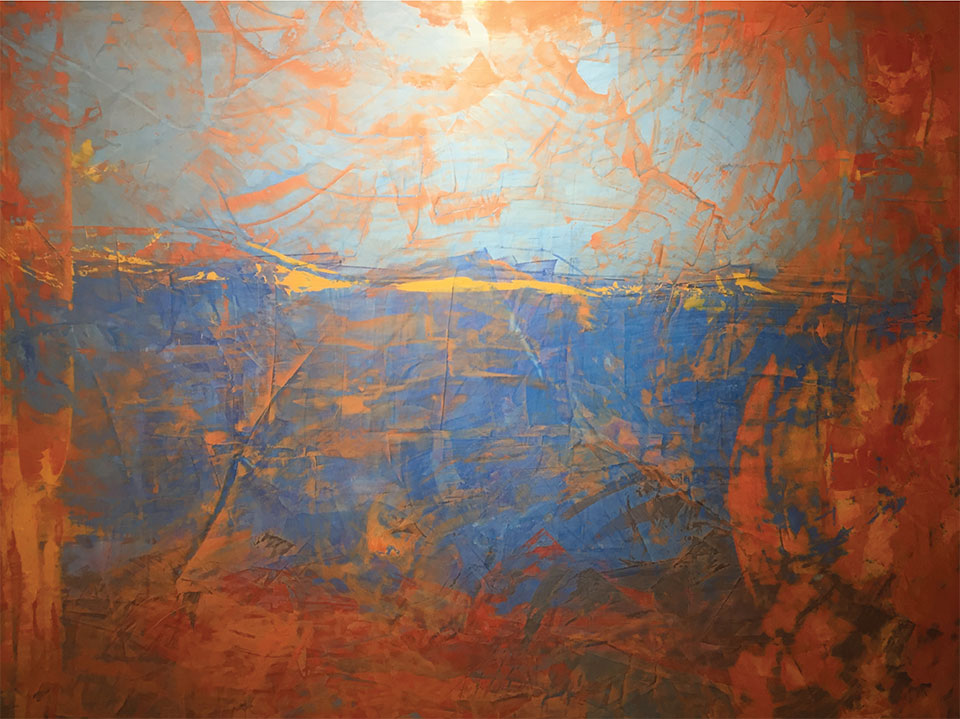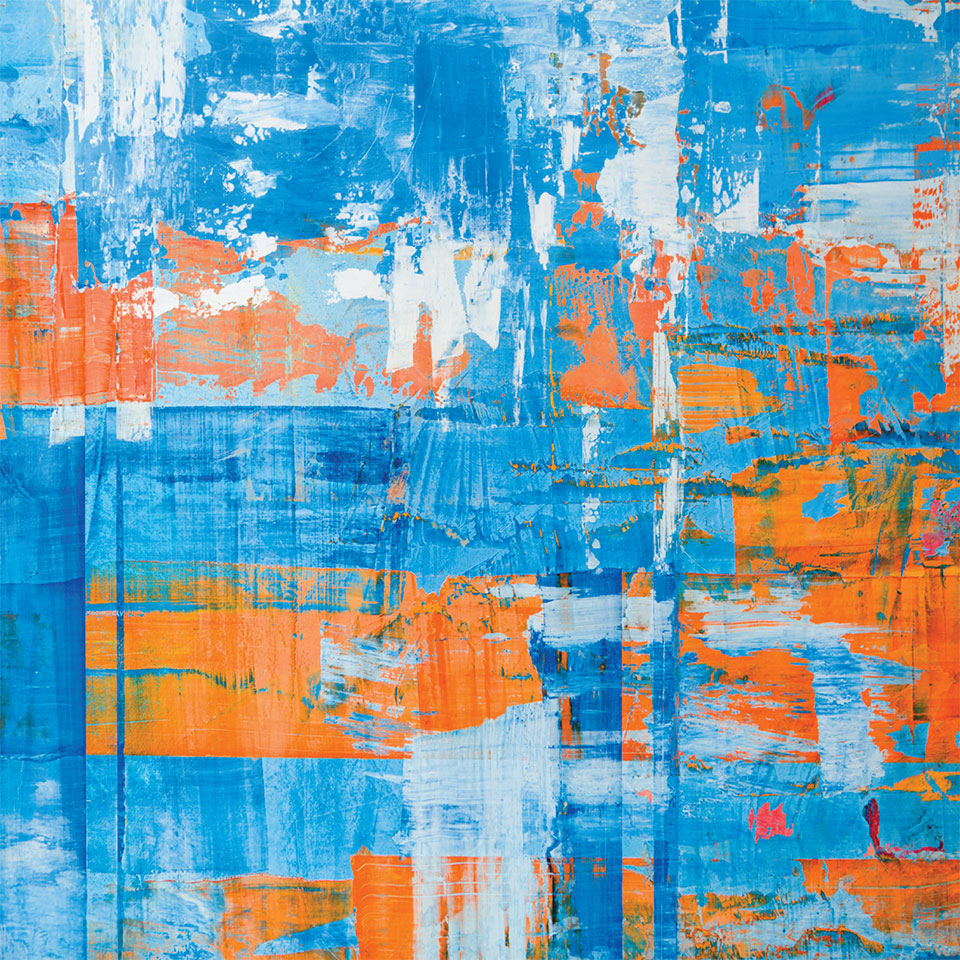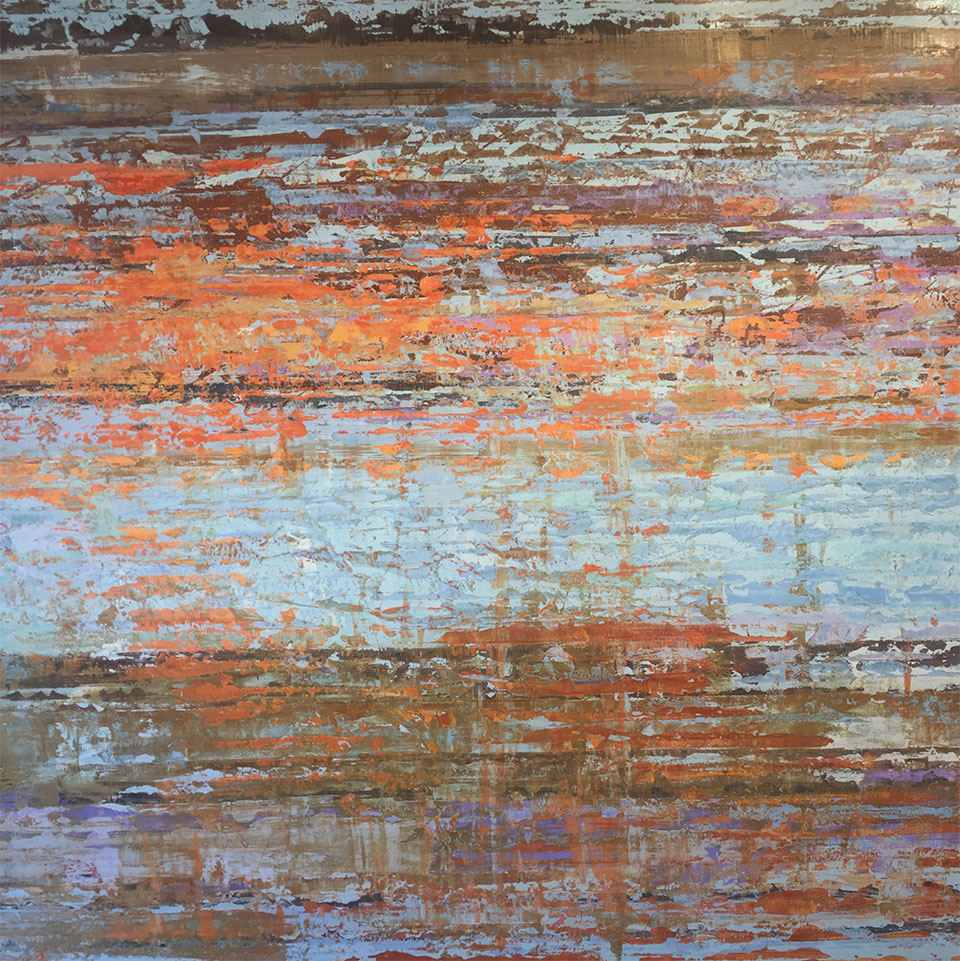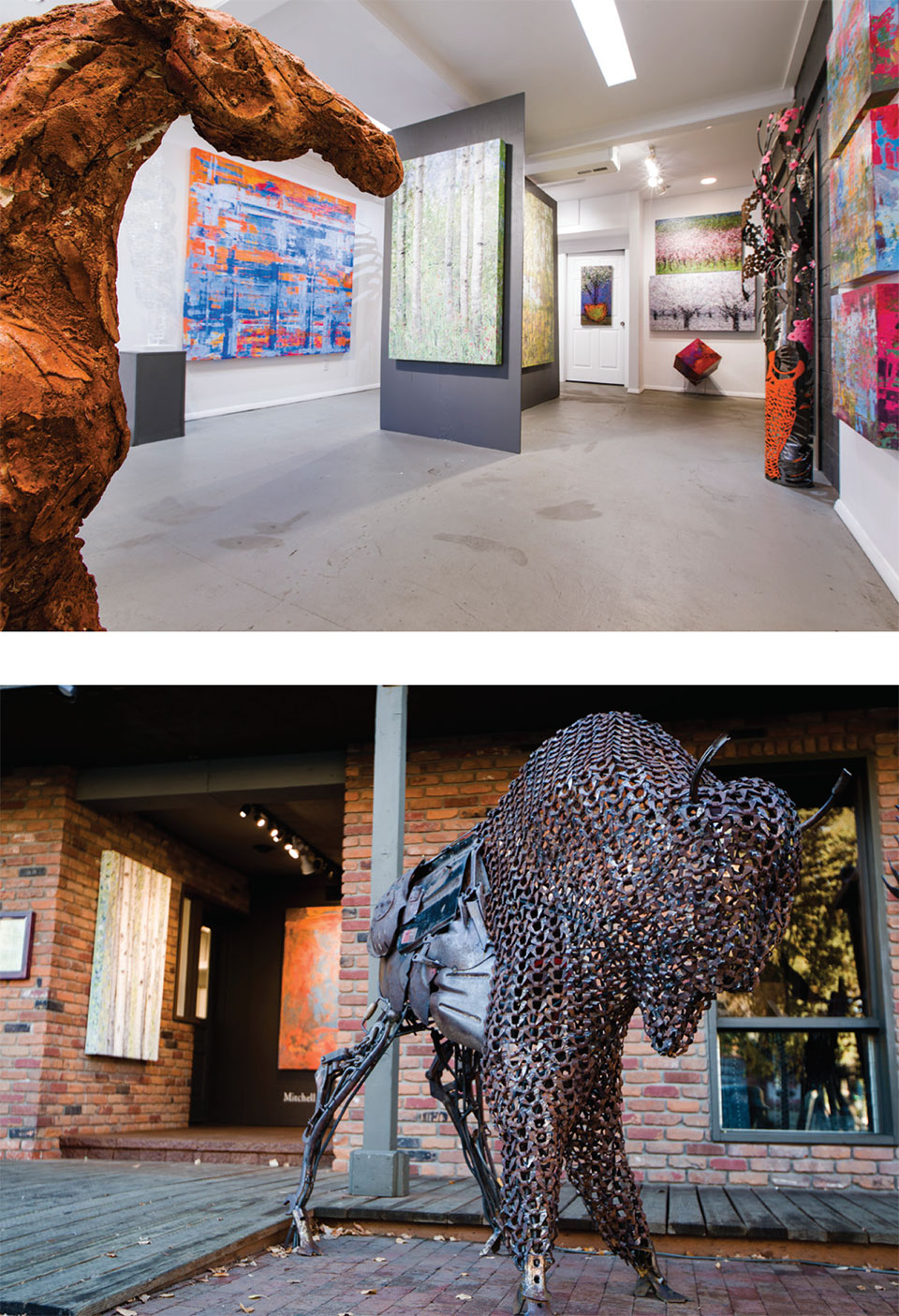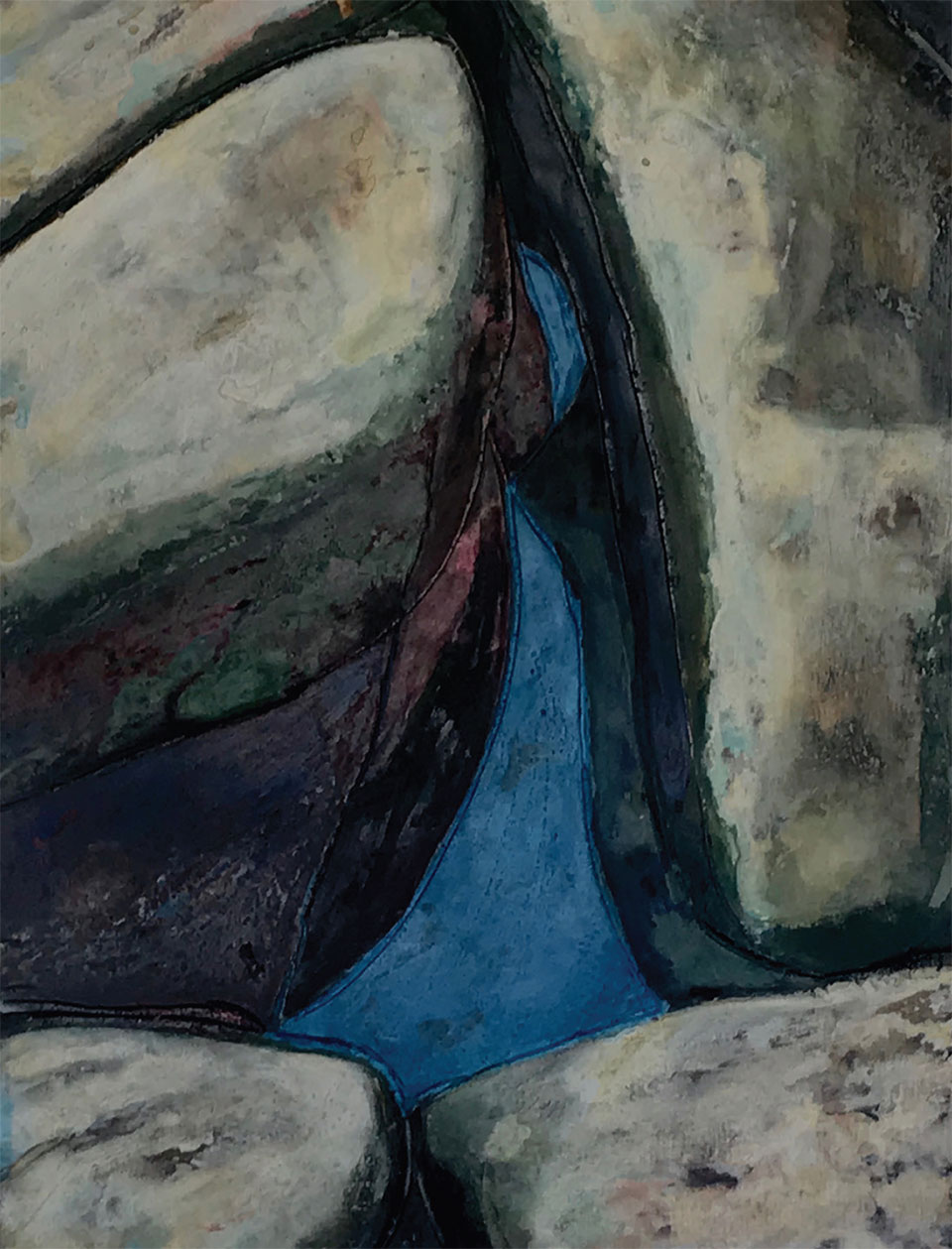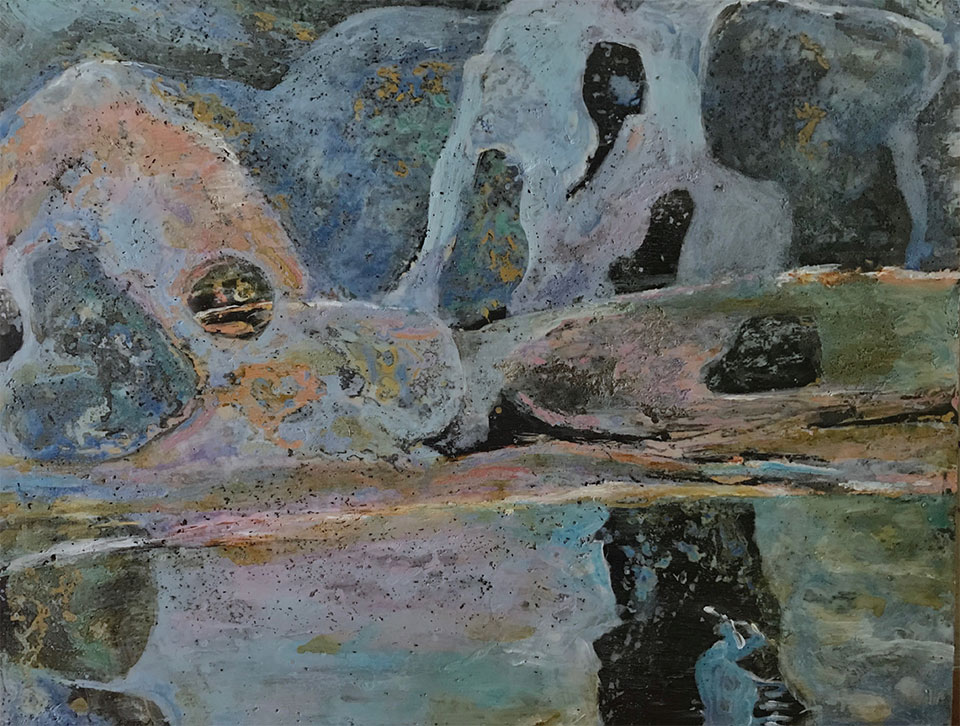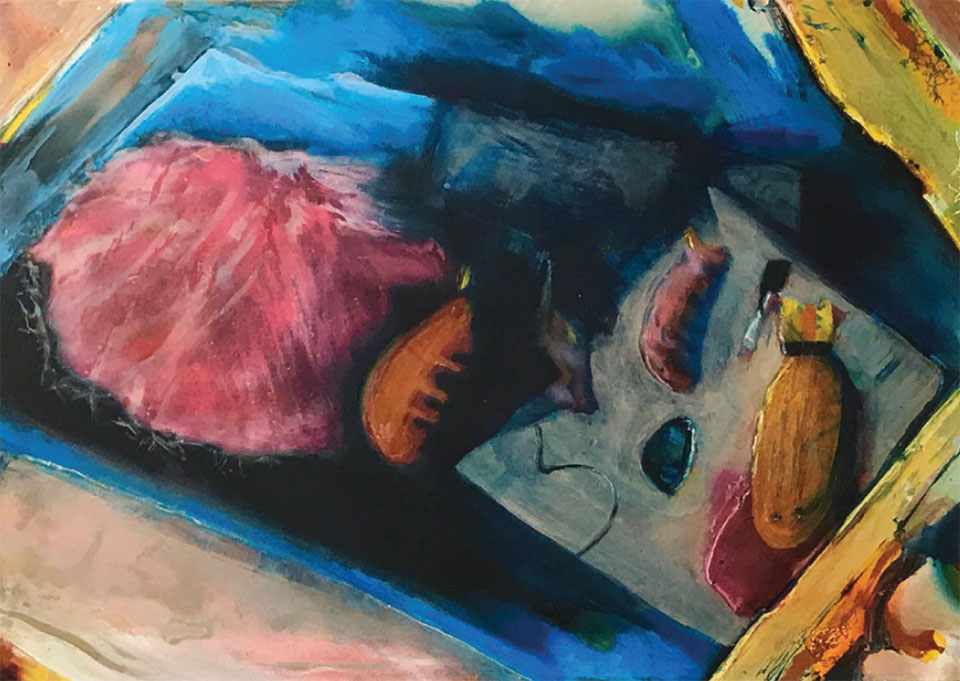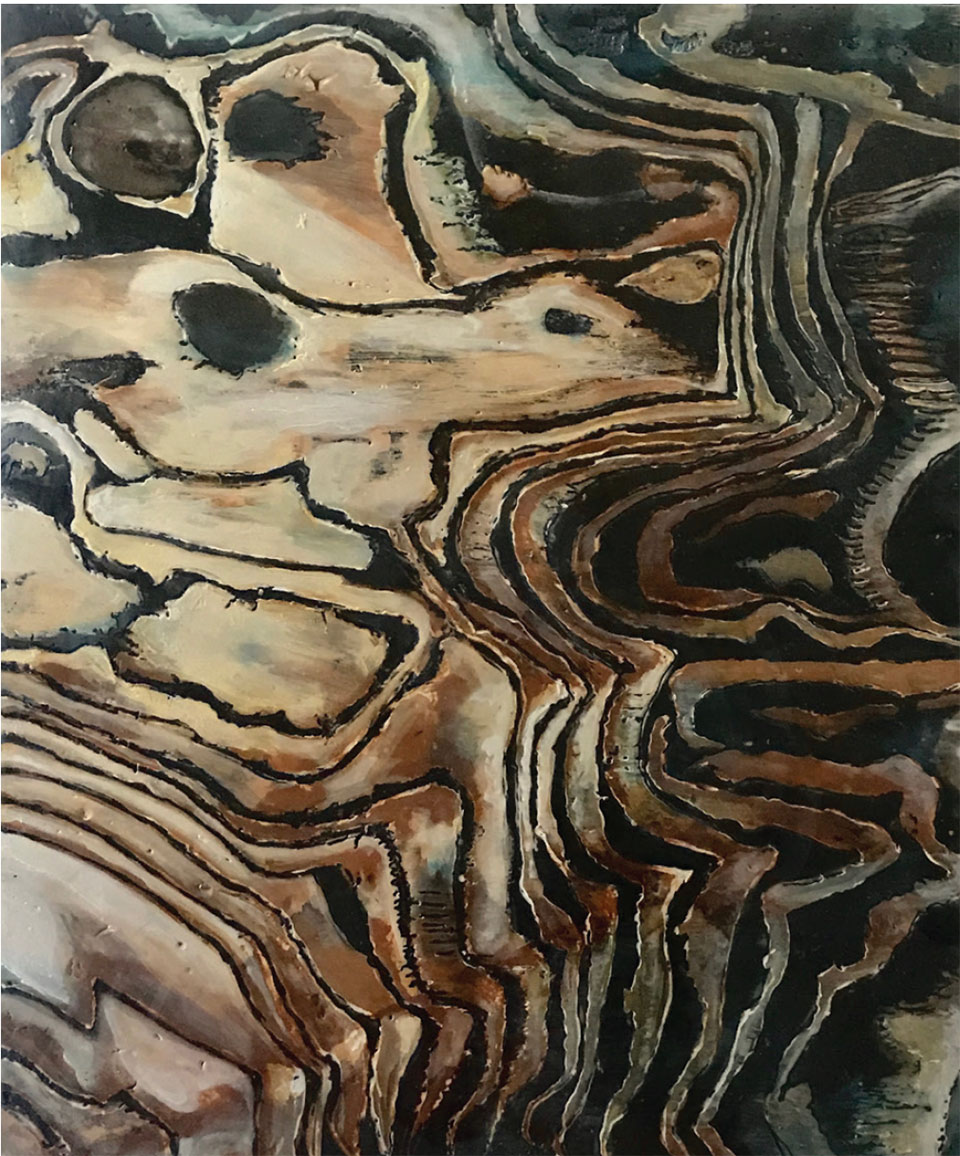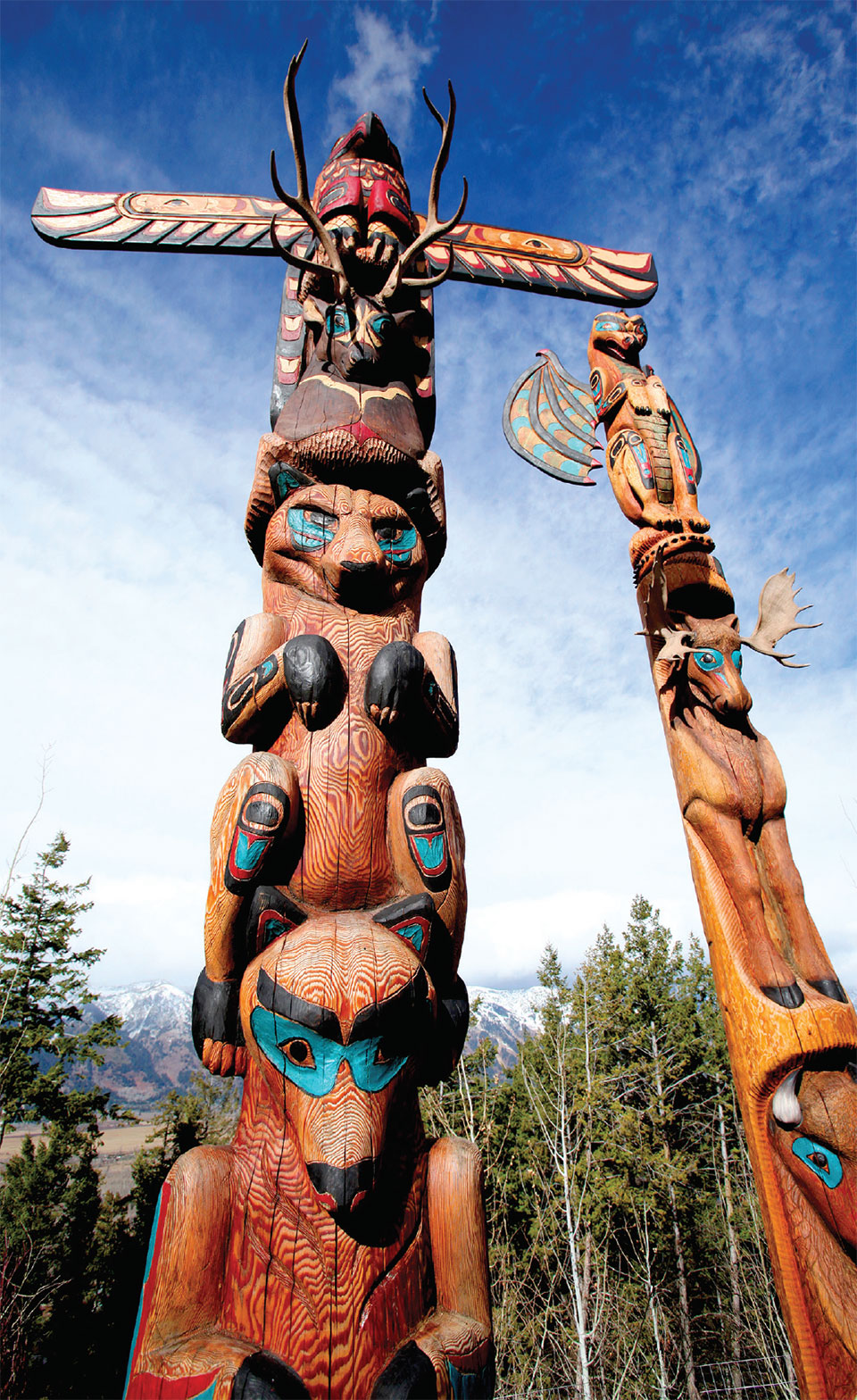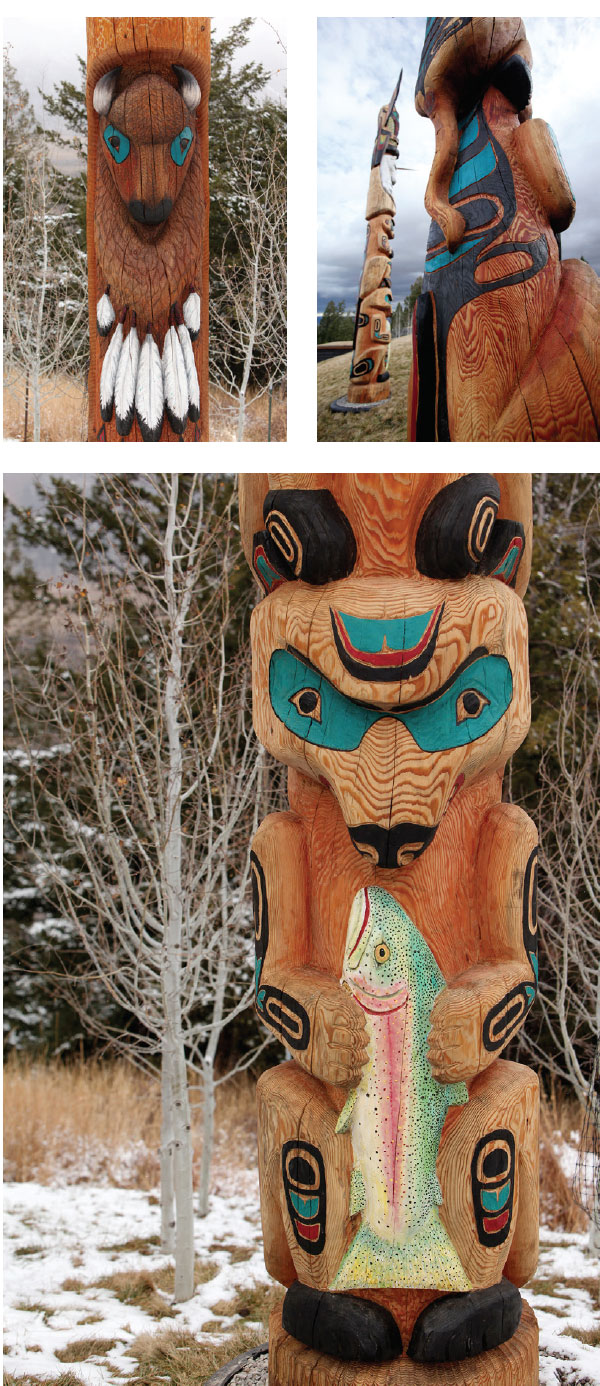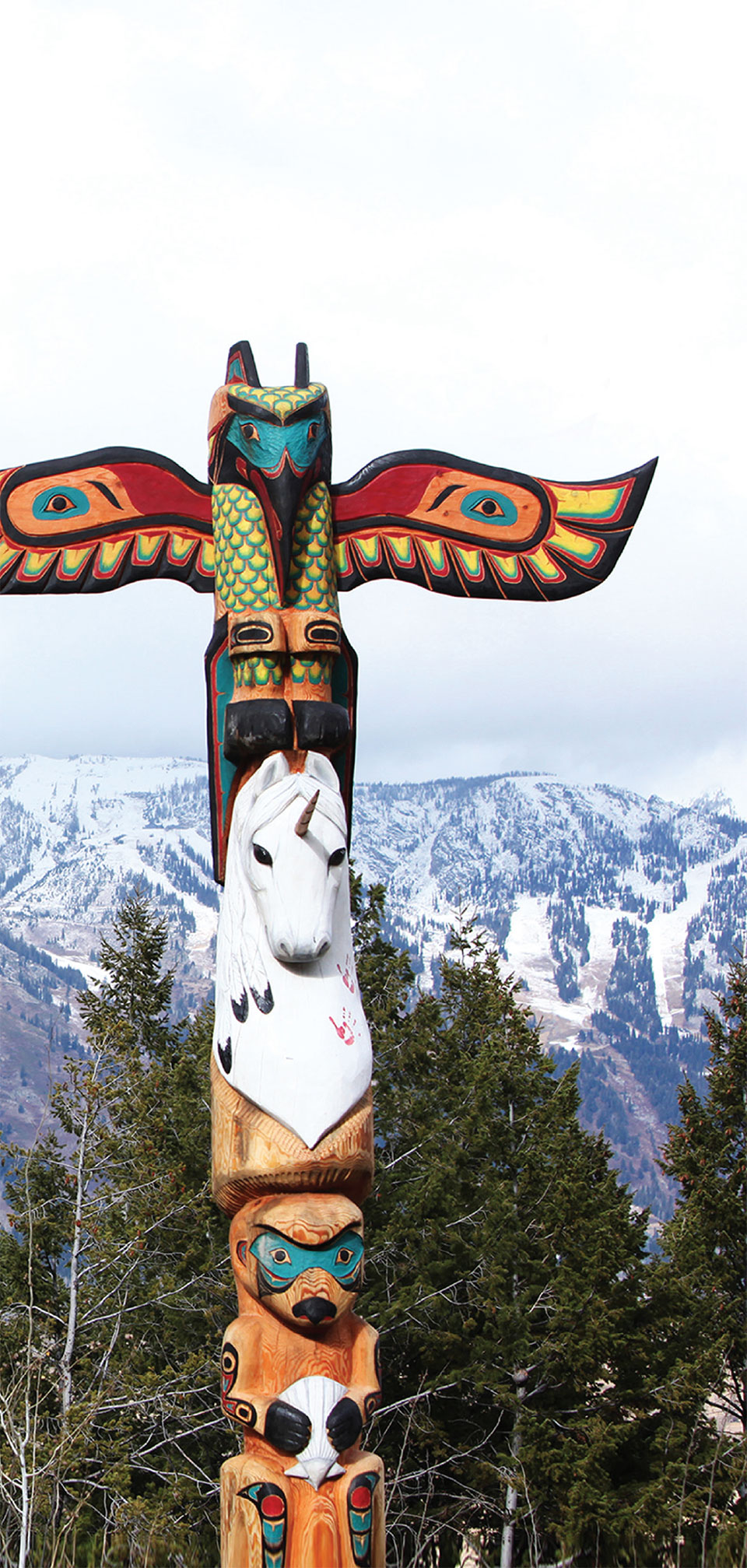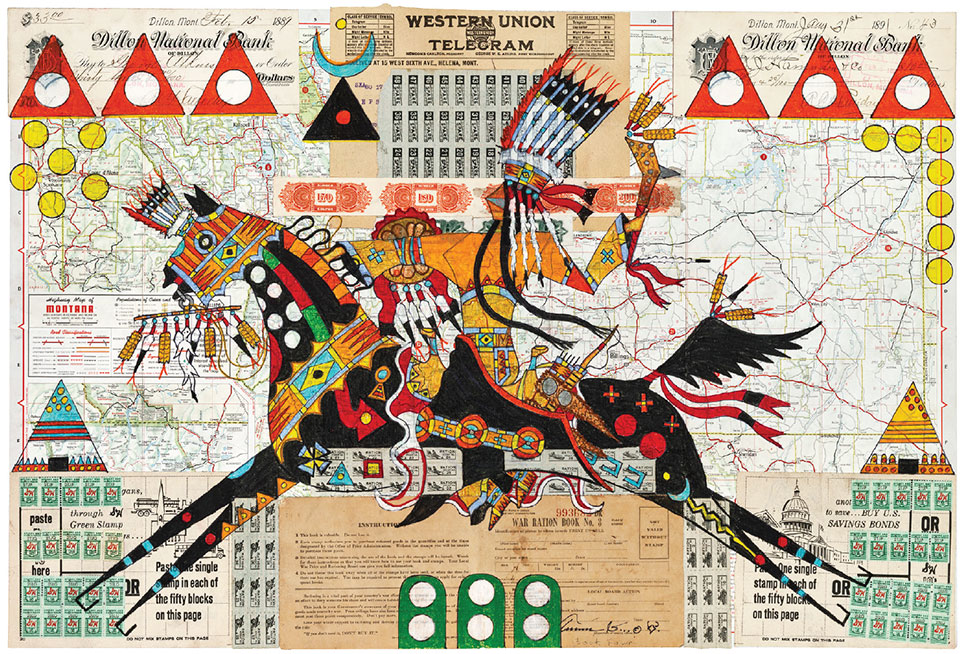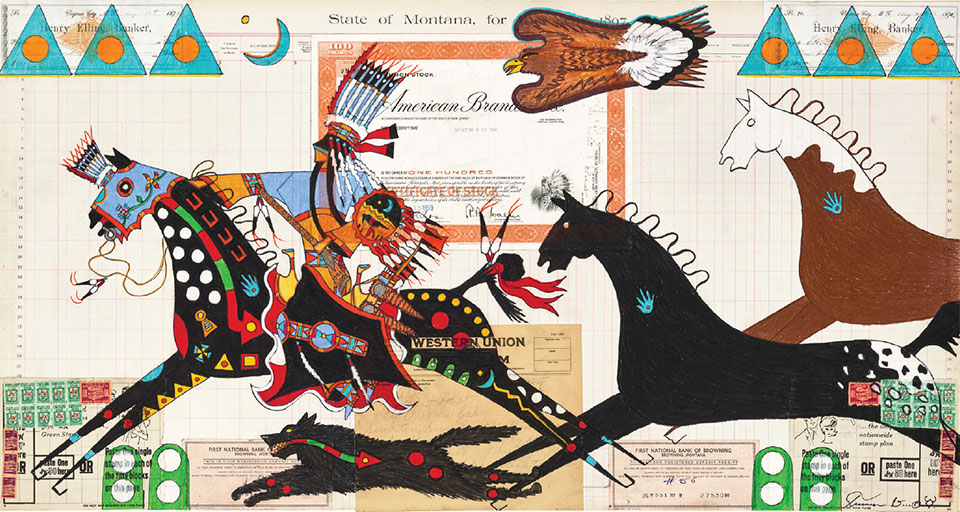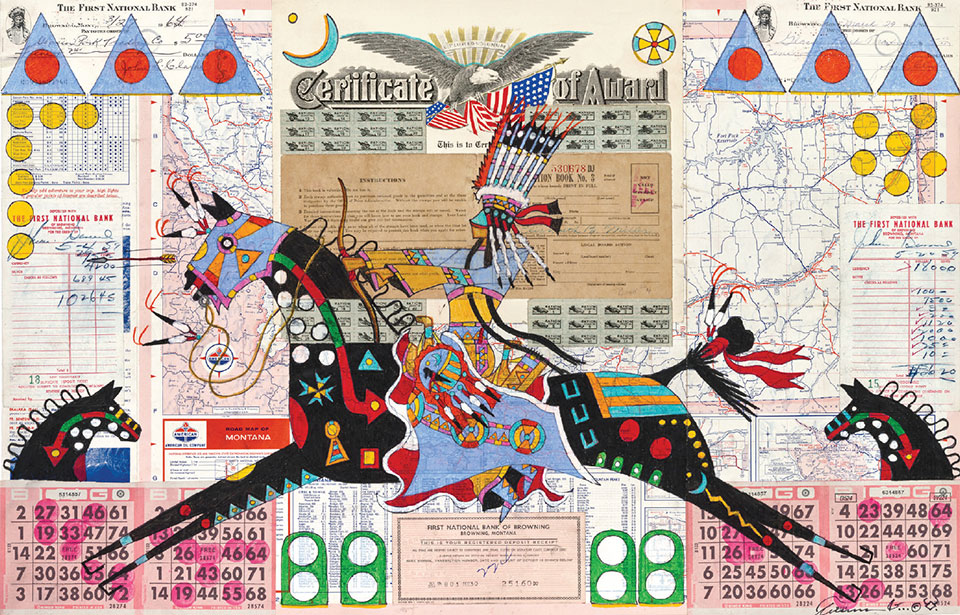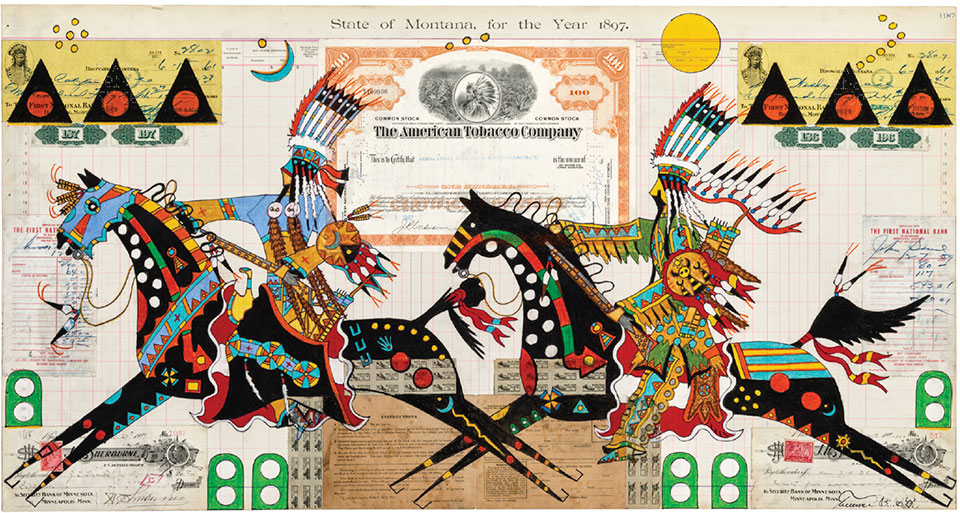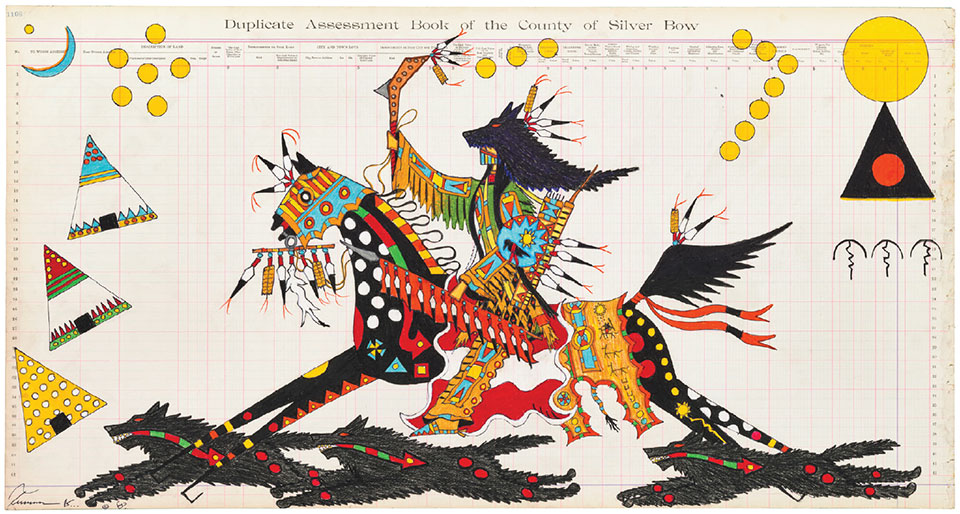In Sun Valley and Beyond
By D. Gibson & Jennifer Walton
“Untitled” by Kristof Kosmowski. Venetian plaster and oil on board, 71.5” x 71.5”, at Mitchell Contemporary.
The attraction to Sun Valley for artists and art collectors as well as many respected art galleries has a long history, and this Western enclave has long been a sought-after paradise for art seekers. In this issue of Western Home Journal, we have uncovered exciting new art, artists, and a gallery representing what is happening in the burgeoning world of Western art in this corner of the West. Tim Mitchell of Mitchell Contemporary has opened up a gallery in the heart of Sun Valley to present works by living contemporary artists whose modern approach to traditional methods and mediums are fresh and new. Valley-based artisan and craftsman, Jon Nasvik, presents his latest concrete artworks that evolve from his unique sense of color and design, which he discovers in his unending desire to work with concrete as decorative art. Tracing his ancestral narrative and existence in the modern world, ledger artist Terrance Guardipee offers a historic lesson in Native American culture with a look to the future. In addition, George Gulli’s craftsmanship for totem pole work connects with collectors and art lovers on a sublime and ethereal level, offering a sense of the past, present, and future. Explore Western fine art throughout this issue of Western Home Journal as another element to discovering or enhancing your dream home and surroundings in the West.
Mitchell Contemporary:
Brings New Contemporary Art Space to Sun Valley
“Untitled” by Kristof Kosmowski. Venetian plaster and oil on board, 48”x 48”, at Mitchell Contemporary.
Tim Mitchell has been an art lover since he attended college at Georgia State University, where he studied and acquired a taste for contemporary fine art under the mentorship of the Atlanta portrait artist L. Comer Jennings, Jr. It was Jennings’ influence that eventually led Mitchell to discover his life’s passion and work, culminating today in the Mitchell Contemporary art gallery in Sun Valley. As a world-traveled art collector and gallerist, it’s no surprise that Mitchell chose Sun Valley as the place to open his newest gallery. Mitchell says, “I’ve always heard about Sun Valley, but I have to let things speak to me, and I came to Sun Valley and fell in love with it. It’s a beautiful town. I love the natural beauty, the mountains, clean air, and excitement of the people who visit and live in Sun Valley.”
For many years prior to landing in Sun Valley, Mitchell acted on his love for art on an extended trip to Copenhagen, where he found himself collecting old works, and realized how much he enjoyed it. He came back to the U.S., and eventually started working in sales for Aspen, Colorado, gallery owner Mark Tye, who gave him the opportunity to be his director and take his current gallery in a new direction. Mitchell also staged and created a series of pop-up art galleries in Aspen and Vail with works by regional artists, emerging artists, and well-established, blue chip artists. Fast-forward to 2018, and Mitchell’s new space on Sun Valley Road features works by artists whom he has represented for years, including Kristof Kosmowski. “Kristof is a world-class artist with Old World roots, and it has been a joy and a pleasure to work with him. I am constantly blown away by his creativity and work ethic. He has been an instrumental part of my success as a gallerist. He’s my main artist, whose work I feature prominently, and he is my featured artist for my grand opening in Sun Valley.”
Mitchell presents works from Kosmowski’s “Abstract Series,” including several of his cubes. Kosmowski is a prolific painter who continuously expands his approach. His inspiration comes from his personal life experiences, but also from the modern masters Claude Monet, Gustav Klimt, Paul Cezanne, Robert Motherwell, and Gerhard Richter. Utilizing the challenging medium of Venetian plaster with inherent oil pigments gives Kosmowski’s work depth, texture, and a rich organic feel. Venetian plaster was used as far back as Roman times, but it became popular during the Renaissance 500 years ago in Venice. It is primarily composed of crushed marble and lime putty, which can be tinted to give a vast array of color. Kosmowski’s distinct color palette inflicts a rich and complex outcome. Each variation infused into the plaster is applied with dissimilar quantity and never measured. A palette knife painter, Kosmowski’s bold use of color, texture, and pastels coupled with his innate raw energy are the signature marks of this Colorado-based, international artist.
“Untitled” by Kristof Kosmowski. Venetian plaster and oil on board, 48”x 63”, at Mitchell Contemporary.
“Kristof is a world-class artist with Old World roots, and it has been a joy and a pleasure to work with him. I am constantly blown away by his creativity and work ethic. He has been an instrumental part of my success as a gallerist.”
–Tim Mitchell
Mitchell Contemporary also presents sculpture by D’Arcy Bellamy, who is based in Boise, Idaho. Bellamy creates figures made from a pipe shaped with a plasma torch. His sculptures reflect the aesthetic of the Japanese philosophy of Wabi Sabi. Other works include sculpture by Siri Hollander, who has become a master of three-dimensional images of horses and has developed her figure sculptures, which are influenced by the emotional impression in the sculptures of modern masters. In addition, Mitchell also presents acrylic on canvas works by Ron Apgar, whose current collection consists of contemporary horse paintings, figurative works, and abstractions.
Mitchell Contemporary also exhibits works by abstract impressionistic painter Diana Carey, who paints with a gestural technique similar to Jackson Pollack but in the vein of Georges Seurat. Carey throws, splatters, and drips numerous layers of acrylic house paint onto prone canvas using brushes and sticks. Mitchell is also excited about his newest addition, Malen Pierson, who is based in northern Utah. Pierson works with used objects and old equipment, which he finds on industrial sites and farms. Currently, his buffalo and moose are on exhibition in front of the gallery.
A long-time client of Mitchell’s, Dr. Constance Chu, Professor of Orthopedic Surgery at Stanford University, observes, “Mitchell has a knack for finding and showcasing unique contemporary art by living artists. Works by Mitchell’s artists have transformed my home and office, bringing emotions and perspectives from nature into daily life. As an investor in the gallery, I am thrilled to see the international mix of talent he is offering to the clientele at a world-class resort like Sun Valley.”
Whether traveling to New Zealand, sailing in Australia, diving in Thailand, or finding his way to Vancouver, Mitchell always has art on the mind, visiting his artists in every corner of the world. Mitchell Contemporary specializes in modern, contemporary paintings and sculpture by established and emerging international and regional artists working in a variety of media including Venetian plaster, oil on board, and acrylics on canvas. Mitchell Contemporary also presents a variety of sculpture pieces in raku, clay, bronze, iron, stainless steel, and copper.
Mitchell Contemporary is located at 400 Sun Valley Road, #102, in Ketchum, Idaho. For more information, email Tim Mitchell at mitchellcontemporary@gmail.com, call 970.404.7206, or visit mitchellcontemporary.com.
Jon Nasvik’s Decorative Concrete Art:
Behold the Beauty
“Cache” by Jon Nasvik. 25½” x 34½”, concrete at Cliffhangers, Inc.
“What’s interesting to me is that I have learned more about the use of color and design in concrete work thAn I did in art school. And, surprisingly even to me, for such a cold, hard material, concrete offers a seemingly endless amount of movement and life to my artwork.”
–Jon Nasvik
If you enjoy the contemporary appeal of concrete as part of a home’s design, you might be interested to know that this ancient building material, deriving from ground limestone rock, can also be exquisite fine art. Sun Valley-based artisan and craftsman, Jon Nasvik, who formed Cliffhangers, Inc. 27 years ago to create functional and decorative uses for concrete, has been an artist as far back as he can remember. An expert and artistic craftsman, Nasvik is in constant demand for the growing number of design-oriented people who recognize the benefits and appeal of concrete.
For more than 50 years, Nasvik has been working in the decorative concrete industry creating functional, beautiful home concrete works and entities for inside and outside the home, including countertops, sinks, walls, floors, fireplaces, and water features. Recently, his use of this decorative concrete knowledge has evolved toward transitioning to studio art. The range of possibilities that this unusual art medium has to offer is intriguing. Nasvik is discovering through his imagination and abilities of working within the medium the seemingly endless possibilities concrete can offer his fine art experience.
“Avocado” by Jon Nasvik. 28½” x 28½”, concrete at Cliffhangers, Inc.
“Apparition” by Jon Nasvik. 30” x 38¾”, concrete at Cliffhangers, Inc.
“It’s art that you can touch and feel,” says Nasvik. “It has a smoothness and/or texture. It’s solid concrete and durable but light enough to hang on a sheetrock wall when cast less than half of an inch thick. Depending on the angle it is viewed from, light will capture the patterns in these pieces, and break up in ways that change the character of the piece. This idea opened my head to evolving beyond painting on a flat plane. Why shouldn’t interesting things be happening depending on the light, and the goal I am trying to accomplish with it?”
It’s true. The work Nasvik puts into his concrete art will reveal different dimensions to the shapes and lines and colors—allowing ongoing exploration and discovery to the eye of the beholder. For this reason, Nasvik is carving and building when creating his concrete fine art pieces. Much of his work is created upside-down and he places actually colored cement, not paint, on a plastic sheet. It is a type of blind process. In another method, Nasvik will build up the colored cement layers, which is more like painting on a board, followed by grinding, chipping, and other methods to make the surface more interesting. Through these two different efforts, Nasvik is often finding new things in the process and, as he says, “I can push into the next piece, and it’s a neverending adventure that continues on toward new discoveries.”
Nasvik uses texture to interpret objects or items he depicts, allowing for changing light, and he’s now working toward more abstract pieces. “Most of the color you see in my work is the cement,” tells Nasvik. “I can apply tints, stains, and color-enhancing sealer as I see fit, to achieve a completed piece.” He adds that he’s noticing different effects along the way through the processes he uses, such as rippling, making more air pockets for definition, and several other practices that are allowing his imagination to explore the infinite possibilities of concrete for fine art. “It’s a new exploration. It is something that has not been tried. It’s fresh and different. The use of the material is fresh, and I have been doing this for over 50 years. I like creating works of art more than anything else I do. I really do think I have something to give with this work.”
“Things in a Box” by Jon Nasvik. 25½” x 36”, concrete at Cliffhangers, Inc.
“Emerging Light” by Jon Nasvik. 37½” x 45½”, concrete at Cliffhangers, Inc.
Picking a color palette is most likely one of the most difficult components for Nasvik, but the process of always learning is very motivating and exciting to him. “Spontaneity, movement, and texture are things that I really enjoy about creating these art pieces,” he says. “What’s interesting to me is that I have learned more about the use of color and design in concrete work than I did in art school. And, surprisingly even to me, for such a cold, hard material, concrete offers a seemingly endless amount of movement and life to my artwork.”
To learn more about Jon Nasvik’s work, call 208.720.1367 or email noj@sunvalley.net.
George Gulli
Dreaming of Totems
By Jennifer Walton
When George Gulli sleeps he dreams of totem poles. He contemplates the massive straight larch logs free of their imperfections, center-lined for their design, and cradled upon several sawhorses. He thoughtfully considers the intricate carvings, which could range from traditional Pacific Northwest Coast Native American tribe symbolism to bold and unique designs that he will arrange on the pole to depict his client’s life, environment, or the poles’ site. As a third-generation carver inspired by his father, his larger-than-life totemic art studs the Rocky Mountains, but also lives as far away as Canada and Ireland. For 37 years, his dreams continue to reflect the gratitude he feels bringing this sacred and oft forgotten art to the world.
The history of totemic art depicts many elements, most notably tribal ancestry, individual clans, wealth, status, and legends. Sometimes events or celebrations were told as stories, hence the reference, “Story poles.” The most identifiable totem poles are those from the Northern Pacific Coast, as in Alaska and British Columbia. However, the American Coast Salish tribes in northern Washington play an essential part in the art’s history and its importance in providing interpretation, cultural teachings, and preservation for future generations. Surprisingly, the word totem is not a Northwest Coast Indian term, nor is totem pole whose origination is an Anglo-European term for “monumental wood pillars carved by people of the northern Pacific Coast.” Rather the terms totem and totemism are “anthropological terms that refers to a variety of beliefs and practices concerning relationships between human groups and natural phenomena, usually animals but also plants, celestial bodies, and other living beings, places, and powers of nature… whose idea-typical version is a free-standing, painted, multi-figured pole, often with outstretched wings.”
*Pauline Hillaire, Scalla-Of the Killer Whale, a Lumni cultural historian.
“Today people want art that they can relate to and enjoy, and I want them to know that if they have a special place and want a carving, I’m their guy.”
—George Gulli
So, how did this soft-spoken, wildly intelligent Montanan whose grandfather carved stone in Italian quarries and whose father relished its medium in wood while living in California, take to carving enormous felled trees that require the ultimate in creative visualization to produce a totem so dictated by precision and patience that few non-Natives are ever fully recognized by First Nation tribes as serious artists? By watching his father. “I didn’t want all the knowledge to go away,” says Gulli, “and I began to understand that with each client, and my experience in getting to know them, and the joy they exhibited in having something made specially for them, a piece that looks beautiful in their yard, was really my joy. Being an artist is wonderful. It works for me.” And his clients agree.
There’s the Canadian brewery that ordered an astonishing 24 poles. And, then there’s the couple from Jackson, WY who upon receiving their first work of art a few years back, proudly claimed, “You haven’t heard the last of us yet!” Their recent installation involved a trio of totems whose carving took 10 months. The images on the poles and the sizes of the poles were requested, however the order of the design and details were up to Gulli’s imagination. And, then there’s musician Jason Mraz, whose pole Gulli states combined “a hummingbird on the back of a surfboard, mixed in with an owl, and a cat holding a guitar that I put strings on.” Traditional? No. Whimsical? Possibly, but as Gulli reiterates, “Today people want art that they can relate to and enjoy, and I want them to know that if they have a special place and want a carving, I’m their guy.”
That special place, whether emotional or physical is what Gulli is tempted by. From designing, to measuring, to the pole’s initial cuts, with traditional hand tools like chisels and calipers, to non-traditional tools like grinders and sanders, and chain saws to “chunk out” large pieces of wood, Gulli realizes it is a privilege to carve for that client. “Being able to expand out of my heart is my greatest joy.” That satisfaction is readily seen in both his traditional and non-traditional designs. When a client asks for an eagle or a wolf, Gulli explains its historical significance. The former is known as smart and resourceful as he rules the sky with the ability to transform himself into a human. The latter is very powerful and known to help people who are sick or in need. Totem poles include various symbols that enact powerful reactions to those who stand beneath the monumental sculptures. Alternatively, the poles can signify the entrance to a property, define an honored location, tell a family’s story or a village’s tale, or commemorate special occasions like marriages and anniversaries. Towering overhead, a totem pole is a complex piece of art constructed from a tree that characterizes an idea or statement and when raised is emblematic of a ceremony.
“People blow my mind with their requests. I am always amazed. It makes my heart full.”
—George Gulli
Gulli’s eye for scale and detail is excellent. Working with poles that range in size from 4’ to a staggering 50’, his process is a lesson in restraint and composure. After the carving is complete, selected areas are hand painted prior to sealing the entire pole for protection. Designs from start to finish can range from six weeks to two years depending on size and style. “People blow my mind with their requests. I am always amazed. It makes my heart full.”
To meet Gulli, visit his studio in Victor, MT, where his passion for poles is palpable. Or, visit his website to inquire about the pole you’re dreaming about.
Terrance Guardipee
Connects the Past, Present, and Future through Ledger Art
Running Eagle Victory Ride by Terrance Guardipee. Oil and pencil, antique Montana map,
antique Montana checks, World War II ration book and stamps, 23” x 18”, October, 2018.
The power of art and its beholder is never so powerful as it is with the work of ledger artist Terrance Guardipee. Guardipee is an internationally acclaimed Blackfeet painter and ledger artist consistently recognized for the traditional depiction of his Blackfeet heritage and contemporary innovation represented through all of his work. He is one of the first Native American artists to revive the historical ledger art tradition, and was the first ledger artist to transform the style from the single-page custom into his signature map collage concept. The map collage concept is based in the ledger art style, but incorporates various antique documents such as maps, war rations, and checks in addition to single-page ledgers.
“It was around 1850, the middle of the 1800s, when the buffalo started to be wiped out,” Guardipee explains. “When the buffalo became scarce, instead of letting our form of pictograph writing or record-keeping die out, we transferred it to paper.” Utilizing antique documents in all of his artwork dating from the mid-19th century, and typically originating from the historical and present Blackfeet homeland of Montana, Guardipee’s work is not only an homage to his ancestors, but it’s also personal to his own family heritage. He adds, “When individual warriors would go into combat, if they lived, they would come home and they would draw what they did in combat.”
Running Eagle, Blackfeet Warrior Woman War Raid by Terrance Guardipee. Oil and pencil, 1897 Montana ledger paper, antique documents, 36” x 19”, September, 2018.
“The ledger paper, antique checks, and documents I use in my artwork are from Montana, which is the ancestral homeland of the Blackfeet (Pikuni) people.”
—Terrance Guardipee
Guardipee is an enrolled member of the Blackfeet Nation of Montana, and illustrates his personal experience of Blackfeet culture in combination with his educational experience in his artwork. Guardipee was raised in the Blackfeet homeland in northern Montana, and as a result, the cultural life and history of the Blackfeet people became a foundational part his identity. Guardipee participates in the traditional Blackfeet ceremonies often depicted in his artwork. His understanding and personal knowledge of authentic Blackfeet history and traditional culture is expressed throughout his work. Guardipee says, “The ledger paper, antique checks, and documents I use in my artwork are from Montana, which is the ancestral homeland of the Blackfeet (Pikuni) people.”
Guardipee lived in Montana until he attended the Institute of American Indian Arts [IAIA] located in Santa Fe, New Mexico, where he studied two-dimensional arts. His educational experience at IAIA enabled him to incorporate the contemporary color palette he is known for in a manner that is consistent with Blackfeet tradition.
Blue Bird Woman by Terrance Guardipee. Oil and pencil, antique Montana map, antique Montana checks, Blackfeet bingo, World War II rations and stamps, 23” x 18”, October, 2018.
“I am so proud to be part of ledger art and its growth and existence into the new millennium.”
—Terrance Guardipee
The innovation Guardipee has demonstrated in his artwork is recognized by numerous museums, prominent Indian art markets, and private collectors.
Through his paintings Guardipee reveals he is, “Showing the change from living in the 1800s… There is a change and evolution with the time. It’s moving forward.”
Running Eagle, Blackfeet Warrior Woman Leader of the Crazy Dog Society by Terrance Guardipee. Oil and pencil, 1897 Montana ledger paper, antique Montana documents, World War II ration, 19” x 36”, August, 2018.
Black Wolf, War Medicine by Terrance Guardipee. Oil and pencil, 1897 Montana ledger paper, 36” x 19”, September, 2018.
Guardipee is the godfather of ledger art, which he created twenty years ago. His work is featured in the permanent collections of prestigious institutions such as the Smithsonian Institute, the Gene Autry Museum, the Hood Museum at Dartmouth College, and the Museum of Natural History in Hanover, Germany. Furthermore, Guardipee was the featured artist at the National Museum of the American Indian in 2007, and was selected to create an image for The Trail of Painted Ponies at the 2008 50th Anniversary Heard Museum Indian Art Market. Terrance has placed first in ledger art several years in a row at Santa Fe Indian Market, as well as winning best of western art in 2017.
